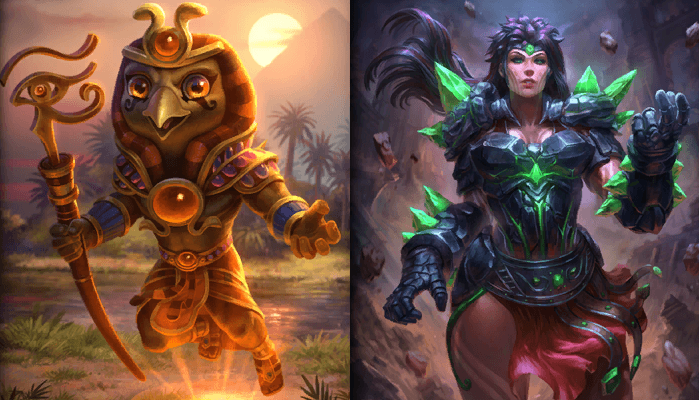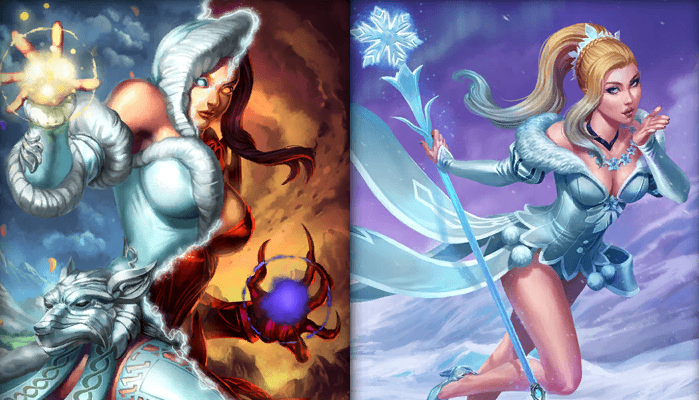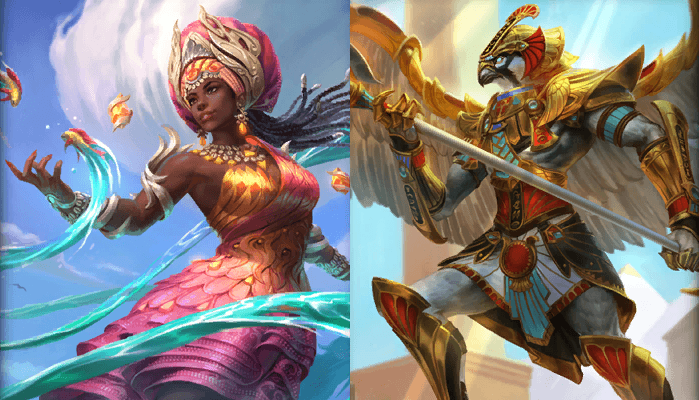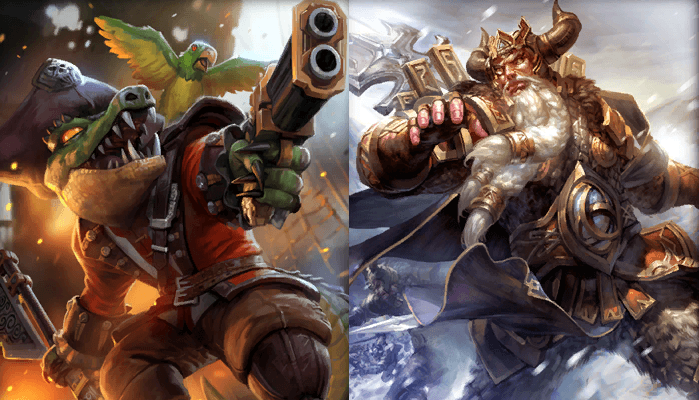The Healing Arms Race in Pro Play - a SMITE Guide
Looking at the healers that are currently being played in professional Smite.
Looking at the healers that are currently being played in professional Smite.
Healers might be becoming the pro meta again. Hel and Aphrodite are constantly banned against some teams while Yemoja and Horus are the most contested supports. Other healers may be making a comeback. Healing lets people fight for longer and out-of-combat sustain can give teams access to objectives they wouldn’t secure otherwise. Anti-heal exists, but sometimes healing is too strong and dominates the game anyway. In this article, we will look at healers in Smite and how they may come to dominate the Smite Pro League yet again.
The most apparent strength of healers is their ability to keep teammates alive during a fight or skirmish. This extends the duration of fights, nullifying the cooldowns and attacks of your foes. Team fights often consist of teams throwing abilities at each other until life bars deplete, but healers increase the effective health of your team. This means that opponents need to use more attacks to win, but they might not have the cooldowns or health to continue fighting into a team with repeated healing. The more healing spells the healer is allowed to throw out, the more lopsided the fight is in their favor.
Healers also scale into the late game. The more items they have, the stronger their healing is. Winning a late game team fight around objectives or towers can end games and healers give a win condition if the enemy cannot instantly burst kill their targets.
In combat sustain is powerful, but a healer’s biggest strength is out of combat healing. If a team fight ends in a stalemate, the team with a healer can refill the team’s life bars and stay on the map while the enemy backs or fights in a weakened state.

Healers can carry games by keeping their team alive for extended periods.
Out-of-combat sustain is also great during fights around objectives. If both teams are damaged and forced to disengage, the one with a healer can just group up, heal, and then take the Fury or Fire Giant. Similarly, healers are great when seiging towers. You can dive a tower, back up when you get poked a bit., then heal up and try again.
Healers are great gods to draft late in the pick and ban phase. Picking a healer late means that that the opponents have less opportunity to draft antiheal gods. This is especially true when the chaos side team can last pick a healer after seeing the entire enemy draft. However, antiheal gods don’t always prevent you from picking a healer. In the SPL, Hel has been selected into a first pick Odin and still steamrolled a game versus one of her hardest counters. In general, it is safer to pick healers after the opponent’s frontline is selected, but not required.
Healers are almost unstoppable from ahead, especially Mage healers. With higher levels of experience and farm, healers can bring more damage and sustain than the opponent can handle. Healers are strongest in the late game and getting them farm ahead of the clock can end a game. Healers can be shut down and camped in the early game, but if the healer is allowed to farm up and reach a few items, they regain the ability to keep their team alive and turn fights around. If you want to shut down a healer, you need to keep them on respawn and unable to catch side waves to quickly gain experience and gold.

Hel and Aphrodite are strong healers that are being picked and banned in the SPL
Aphrodite and Hel are the most popular Mage healers in the SPL. Both are played in the mid lane and the individual pros seem to favor one over the other. Some teams get Hel banned from them and others see Aphrodite removed. A few teams do not seem to want play Hel or Aphrodite, but if a healer meta comes out, they better start playing some healers.
In mid, healers are allowed to build more power than the solo or support roles, so they can get more healing out of their builds. However, Hel and Aphrodite are not yet the best mid picks in the SPL. Gods like Persephone, Merlin, and Raijin are more likely to show up in picks and bans. The healers tend to do less damage or less safe damage than other top mages. Hel has great burst, but needs to be close to her enemies. Aphrodite was recently buffed so that her Love Birds do more damage and also has a burst spell that fires around herself and her soulmate. Healers can put out good damage in team fights, but they have to be aware of their allies and not just chunk out enemies and run from danger. A lot of healers thrive in the midline of team fights. Out of the reach of enemy front liners, but also close enough to support their allies.
Other Mage healers see play in the SPL. Olorun and Baron Samedi have been played a bit since the season started, with Olorun seeing more play than Voodoo god. Olorun isn’t considered a healer in assault, but he comes with good healing. Baron Samedi is played in the solo lane as a brusier mage. His healing is more conditional that the others because he needs to hit enemies with Consign Spirits to generate a heal. Ra received a buff in Patch 7.4 and has been picked a couple times since. Chang’e, who is currently seeing rare target bans against solo laners, is getting a small buff in 7.5. None of these gods are as powerful healers as Aphrodite or Hel, but if a team wants to force a healing composition, they are viable options and can be paired with another healer in a different role.
Most of the higher-tier Mages easily apply Divine Ruin, reducing the effectiveness of healers. Gods such as Merlin, Raijin, and Discordia have big AoEs to spread Divine Ruin among your team. Healers are still very playable with 40% reduced healing, especially as their out-of-combat healing isn’t impacted by anti-heal, but once a team can stack Divine Ruin with Brawler’s Beatstick or similar effects, Mage healers don’t do much in teamfights besides damage and being squishy priority targets.

Some Mages aren't amazing healers, but pair healing with other strong utility traits.
Yemoja and Horus are two of the best supports in Smite and both are healers. Horus’ heal isn’t too strong, but it is there, and it can sustain the whole team during a reset. Yemoja has a potent heal that she can spam in the aftermath of fights and her Omi mechanic means that she can throw a few Mending Waters in a fight with no cooldown. However, spamming healing means Yemoja cannot cast her other spells for a few seconds. Yemoja and Horus are less primary healers and more so supports with great level one pressure and utility, with healing being a part of that utility.
Other tanks have healing abilities too. Guan Yu, Sylvanus, and Terra all have good healing and can sustain up a team during and after fights. Out of these gods, only Terra is getting SPL play, and she isn’t very popular. Tank healers generally aren’t the best healers, but the general healer dynamics still play out if one team has a support healer and their opponents don’t. Tank healers also fair better into antiheal. They are still meat shields who have crowd control and utility to contribute to teamfights.

Yemoja and Horus are the premier supports in Smite right now.
Healers can be very strong in Smite, but counters exist. Several items have the anti-heal stat on them. Divine Ruin, Brawler’s Beat Stick, Pestilence, Contagion, and Toxic Blade reduce the healing that enemies receive. Cursed Ankh is the anti-heal Relic. Using it reduces the healing received by nearby enemies. When upgraded, Cursed Ankh causes enemies that get healed to take additional damage for the duration of its antiheal effect. These items can easily combine to achieve 100% antiheal on whatever target you focus.
Some gods also have anti-healing traits. Gods like Sobek, Bacchus, and Cerberus have abilities that reduce the healing received by enemies. Other gods have abilities that completely nullify healing. The ultimate abilities of Odin, Serqet, and Osiris come with 100% anti-heal. Unlike the partial anti-heal abilities, increased healing effects do not work on targets under these ultimate effects. It isn’t always possible to draft anti-healing gods in response to healers and when you can pick up these gods, they should be used along with anti-heal items.
In addition to anti-heal, there are also strategies to combat healing. These should be used in conjunction with anti-heal items. Healers prolong fights, so focusing them will prevent fights from snowballing away from you. A lot of healers, especially Aphrodite and Hel, have ways to get themselves and their allies out of danger, making the task of killing them more difficult. However, the risk is usually worth it. Killing the backline Mage is often a priority in fights, and when that Mage keeps the rest of their team alive, they are even bigger targets.
Similarly, healers are great in the late game, so building aggressive compositions that are designed to end the game early can be successful. However, if an early game comp does not snowball and end the game quickly, you just lose to the team with a late game healer.

Some gods have built-in anti-heal.
Healers can be very strong in Smite. Aphrodite and Hel currently have decent presence in the Smite Pro League and other healing Mages may be joining them. Yemoja and Horus are great supports that also heal. Healers can make the game unfun if they get a lead and can still dominate a game if put behind early. Healing can be countered by anti-heal on gods and items, but out-of-combat sustain is a major source of healing’s power. A pro meta where healers are sometimes picked can be fun, but sometimes there are too many games revolving around healers in the SPL. It will be interesting to watch the progression of healers in the Smite Pro League and see if a full-on healing meta erupts or if healers remain bit players that show up at a reasonable rate.